|
S u b - S a h a r a n A f r i c a
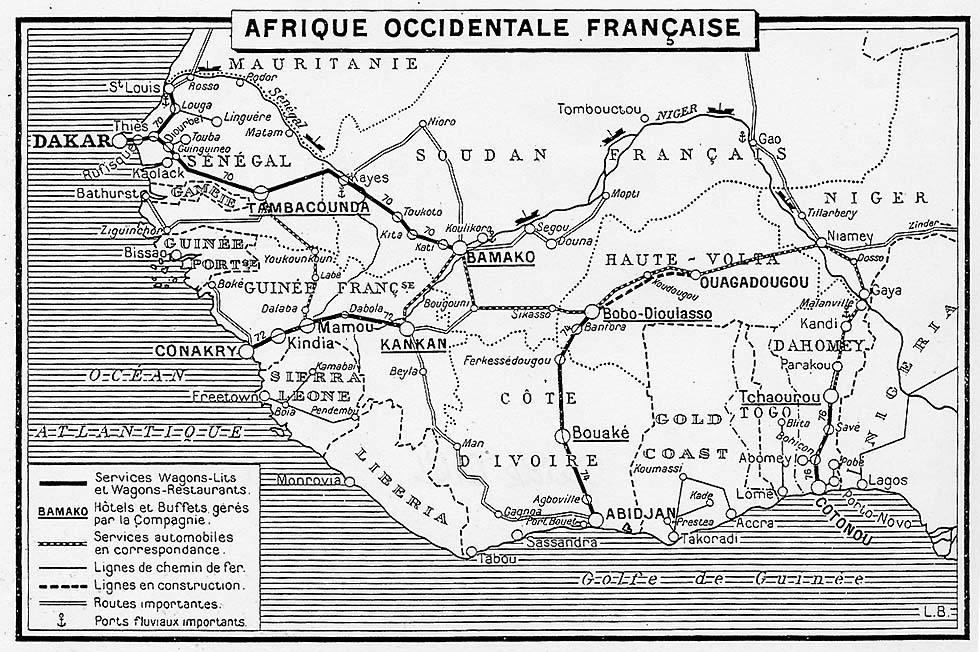
The former French West Africa (Guide CIWL 1959)
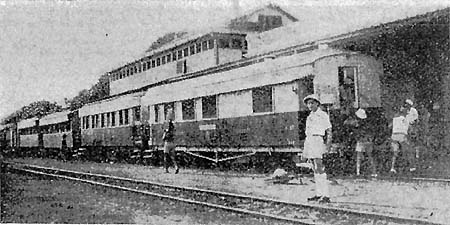 Express Conakry - Kankan, diner and sleeper with CIWL service, at Conakry station (coll. John Price)
Express Conakry - Kankan, diner and sleeper with CIWL service, at Conakry station (coll. John Price)
The Méditerrannée-Niger had never reached Sub-Saharan Africa. Its northernmost railway is the Daka-Niger between Senegal and Mali - a part of “La France d’Outre-Mer” during the colonial epoch. Under General Faidherbe a line Dakar - Saint-Louis was completed in 1885 and another one Kayes - Bamako in 1904. They were connected only by the Senegal river. In 1924 the direct link was established, the Dakar-Niger, 1230 km on meter-gauge. “L’ express du Soudan” was hauled by tenwheelers, but then also 4-8-2+2-8-4 type Garratts appeared on the Dakar-Niger, probably for freight. A direct railway link southward to the tropics never was established. Meter gauge railways connected the countries of “La France d’ Outre-Mer” only with its main ports.
CIWL services in West Africa started in 1936 (according to Dr. Fritz Stoeckl). Between the wars CIWL offered sleeping- and restaurant-services in state-owned cars attached to regular trains:
Dakar - Bamako (Senegal - Sudan Francais, now Mali);
Conakry - Kankan (Guinea)
Abijdan - Bobo - Dioulasso, extension to Ouagadougou (Cote d'Ivoire - Haute Volta, now Burkina - Faso);
Cotonou - Tchaourou (Dahomey, now Benin);
Douala - Yaounde (Cameroun);
Pointe Noire - Brazzaville (Cape gauge Congo-Océan).
From the Dakar-Niger a couplage of a "voiture cuisine-bar" and a "voiture-restaurant", from the Congo-Océan old-style sleeping and dining cars are documented by rare drawings (which had been saved by Roger Commault and Maurice Mertens). Some lines were interconnected by "services automobiles", temporarily also by river steamers. In the years after WWII, diesel railcars came in use and CIWL handed over the services to the railways of the now liberated countries.
Among the engines in Guinea were Mallets of the Dakar-Niger, Cote d’ Ivoire had Mikados, Mallets and Garratts and on the Congo-Océan Mikados as well as 4-8-2+2-8-4 Garrats from the British War Department were used. After dieselization they were sold to Mozambique. In Guinea appeared a prestigious diesel railcar type built by MAN. Later dark-red conventional passenger trains with old Alsthom diesel locomotives became worn-down. Prestige had the French diesel railcar sets on the Abidjan-Niger in Cote d’Ivoire, the yellow “Gazelles”. The ordinary green/light-green expresses had been hauled by French B-BB diesels. Cook’s Overseas Timetable reported in 2008 that the line from Ouagadougou to Tambao close to the border of Mali is under construction. In Benin the harbour Cotonou contined to be connected with Parakou.
The only real “train de prestige” in West Africa however became the express Dakar-Bamako on the former Dakar-Niger, when it was equipped with rebuilt cars from the famous French rapide Mistral, once world’s fastest train, sent in 1991 - for railwaymen of Senegal “Le Mistral”. Before, that train was the “Mali-Express” with brown/red/cream colored old cars including a sleeper, hauled by Alsthom or Henschel diesels and then by General Motors, dark-green ones in Senegal and blue ones in Mali. Then blue second-hand Forestier type cars appeared on the Mali train and Senegal got the “Mistral”. In the new century the timetable showed only one train weekly by Transrail, then running only “every 8 or 9 days”.
"Le Mistral"
SNCS, meter gauge, departure Dakar, Feb. 2000:
| Diesel (CoCo, GM) SNCS | Dakar - Kidira
| Diesel (CoCo, GM) RCFM | Kidira - Bamako
| 1 Fourgon-generateur | (van) | Dakar - Bamako
| 1 1re lits | (sleeper) | Dakar - Bamako
| 1 1re classe | (1st class) | Dakar - Bamako
| 1 Restaurant | | Dakar - Bamako
| 6 2me class | (2nd class) | Dakar - Bamako|
| | | | | | | | | | | | | |
Colors: Rebuilt cars from French "Mistral" stainless, locomotive SNCS dark-green, RCFM blue/white (photo see chapter 850-12).
Once weekly, alternating with the once-weekly Mali Express by RCFM, which consists of ex French Forestier-style cars, blue/light-blue. Motorcars are conveyed on flat-bed wagons.
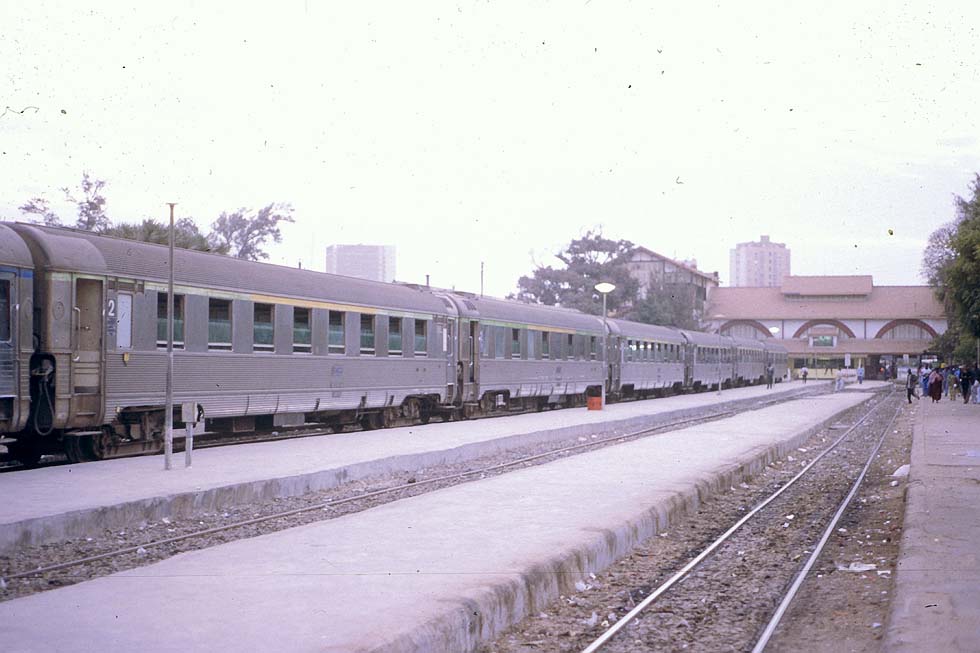
„Le Mistral“ Dakar – Bamako, Dakar Feb. 2000 (WS)
Download this picture with 1500 x 1000 pix, 300 dpi

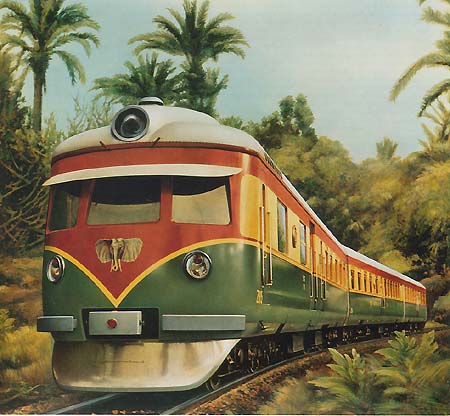 Diesel railcar unit for meter-gauge ONCF de Guinee, consisting of engine car A with 2nd class, trailer B with 1st class reclining seats and dining room, engine car C with 2nd class, built by MAN. Similar trains were delivered also to Brazil (MAN)
Diesel railcar unit for meter-gauge ONCF de Guinee, consisting of engine car A with 2nd class, trailer B with 1st class reclining seats and dining room, engine car C with 2nd class, built by MAN. Similar trains were delivered also to Brazil (MAN)
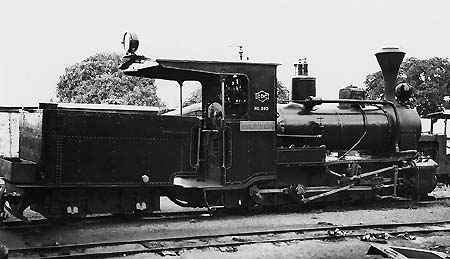 Locomotive 203 "Gouverneur Ebermaier" of CDC, Cameroon, April 1975 (Jeremy Wiseman)
Locomotive 203 "Gouverneur Ebermaier" of CDC, Cameroon, April 1975 (Jeremy Wiseman)
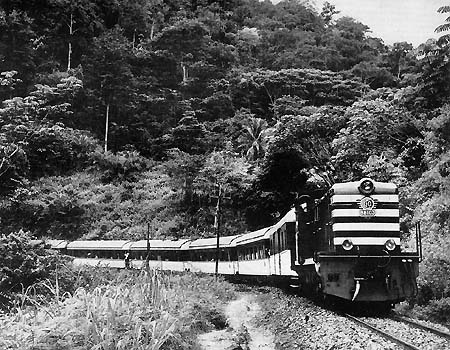 Chemins de fer du Congo-Ocean, diesel BB103 and a car type which was used also in a diner and a sleeper version for CIWL services (Alsthom advertisement)
Chemins de fer du Congo-Ocean, diesel BB103 and a car type which was used also in a diner and a sleeper version for CIWL services (Alsthom advertisement)
The Cape-gauge "Congo-Ocean" connecting Brazzaville, the capital of formerly French Congo, with the harbor Pointe-Noire, was completed in 1934. After the end of steam traction, Alsthom BB-BB diesels hauled the old maroon/cream colored expresses. Towards the end of the '80s came the new night "rapide", consisting of air-conditioned dark-blue/light-grey cars, including a diner, and an orange/grey Alsthom, but also new blue General Motors arrived. Later the night train was replaced by the daylight train “L’ Ocean”.
A spectacular new standard gauge line was built in formerly French Gabon, the Transgabonais. Starting at the port Owendo near Libreville, it reached N'Djolé in 1979 and Franceville in 1986. Alsthom and General Electric diesels of the OCTRA rumbled through the tropical forests with modern yellow/white passenger cars, including a "Premier-Plus VIP" car and motor car transport.
Germany had built meter gauge lines in Togo and Cameroon before WWI. In Togo still towards the end of the 20th century there had been passenger trains from Lome northbound, consisting of decades-old brown/cream colored wooden cars and a yellow Canadian diesel engine. Then Cook reported that the SNCT "has closed". In Cameroon even after the end of French rule the green/cream colored expresses showed the style of "La France outré-mer". Services Douala – Yaounde continued.
Of course the British empire had its railways. On the formerly British Gold Coast Railway, now Ghana, a special boat-train waited on Cape gauge at Accra for the passengers of the Elder-Dempster liners. The expresses were hauled by tenwheelers offrom 1924 and from 1939 by beautiful red Pacifics. The Mountains and Garratts were for freight. In Nigeria Cape gauge railways connected Kano with the ports of Lagos and Port Harcourt. All-steel sleeping cars offered comfortable compartments with en-suite facilities. From 1930 the mighty 806 class 3-cylinder mountains fromdelivered by Vulcan stormed from Lagos to Jebba. The North Mail or Boat Express Lagos-Kano and the Ocean Mail Kano-Lagos however generally were hauled by the Pacifics from 1926. The Garratts were for freight trains. Still in the 21st century train services in Ghana and Nigeria were continued.
Also Sierra Leone and Liberia had got railways. They were closed down, but a passenger service in Liberia between Monrovia and Bong Mine Town was re-opened. Even Fernando Póo island had a rack-and-pinion line and an old postcard showed a tiny passenger train with a Maffei tank locomotive on the formerly Portuguese island of Sao Tomé.
On many railways of Sub-Saharan Africa, passenger services were closed down. Cook showed e.g. in 2005 showed passenger trains Abidjan - Bobo Dioulasso in Cote d'Ivoire and Burkina Faso, but in 2002 they had been interrupted by civil war. Ghana, Benin, Cameroun and Gabon continued services. Trains in Guinea, Sierra Leone, Liberia and Togo were suspended, in Nigeria they were "liable to suspension" and on the Congo-Océan the Train Bleu and the night train L' Eclair were "currently suspended"". For building the line, completed in 1934, more than 15000 workers had died...
In Nigeria the 1067mm-gauge network was modernised, new standard-gauge projects emerged, the Chinese CCECC completed in 2015 Abuja – Kaduna and plans Lagos – Abuja, Port Harcourt – Maiduguri and others emerged.
The drawings of cars used by CIWL in Sub-Saharan Africa are published by "Repas Bleu" issue 48 (contact: robertheron120@btinternet.com).
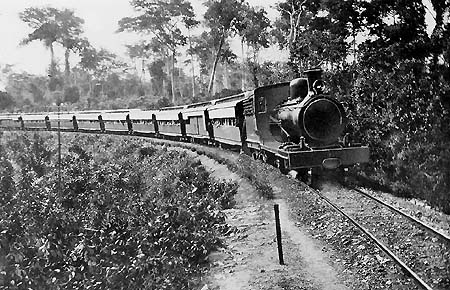
Express between Kumasi and Accra, Ghana ("Gold Coast Railway" c.1924/ Deutsches Museum)
|
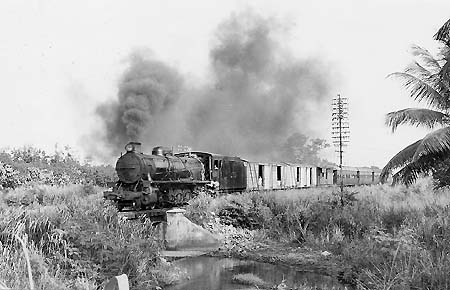
Mountain type engine no.275 at Achimota near Accra, Ghana, July 1973 (Jeremy Wiseman)
|
Three-cylinder Mountain no.806 at Ebute Metta Junction, Nigeria, 1964 (Jeremy Wiseman)
|
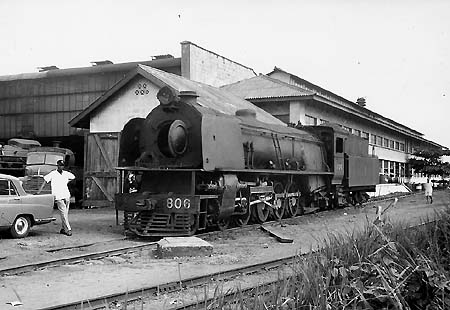
|
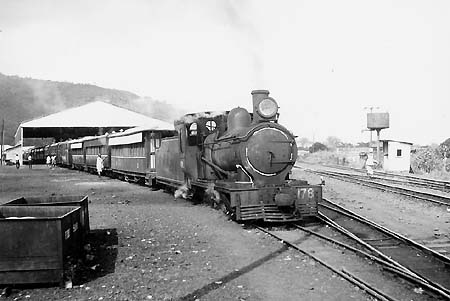
Four-coupler no.178 shunting near Freetown, Sierra Leone, Nov.1964 (Jeremy Wiseman)
|

Maffei tank engine at Sao Tome island (old postcard/ coll. C. Salmeron Bosch)
|
|
 Diesel railcar unit for meter-gauge ONCF de Guinee, consisting of engine car A with 2nd class, trailer B with 1st class reclining seats and dining room, engine car C with 2nd class, built by MAN. Similar trains were delivered also to Brazil (MAN)
Diesel railcar unit for meter-gauge ONCF de Guinee, consisting of engine car A with 2nd class, trailer B with 1st class reclining seats and dining room, engine car C with 2nd class, built by MAN. Similar trains were delivered also to Brazil (MAN)
 Locomotive 203 "Gouverneur Ebermaier" of CDC, Cameroon, April 1975 (Jeremy Wiseman)
Locomotive 203 "Gouverneur Ebermaier" of CDC, Cameroon, April 1975 (Jeremy Wiseman)
 Chemins de fer du Congo-Ocean, diesel BB103 and a car type which was used also in a diner and a sleeper version for CIWL services (Alsthom advertisement)
Chemins de fer du Congo-Ocean, diesel BB103 and a car type which was used also in a diner and a sleeper version for CIWL services (Alsthom advertisement)



 Express Conakry - Kankan, diner and sleeper with CIWL service, at Conakry station (coll. John Price)
Express Conakry - Kankan, diner and sleeper with CIWL service, at Conakry station (coll. John Price)









